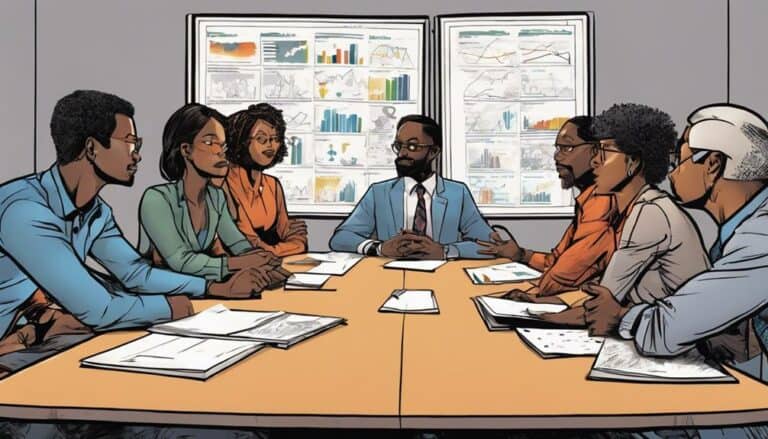When leaders prioritize communication, teams thrive. Imagine a scenario where a team's productivity soared after the leader implemented a structured feedback system. By utilizing tools like active listening, fostering open dialogues, and implementing clear communication channels, leaders can greatly enhance team dynamics and performance.
But what about the nuances of non-verbal communication and virtual team settings? Let's explore how leaders can navigate these challenges to create a culture of effective communication that drives success.
Key Takeaways
- Foster open communication to build trust and engagement.
- Address communication barriers like cultural differences promptly.
- Conduct regular team meetings to enhance collaboration.
- Practice active listening techniques to improve understanding and team dynamics.
Importance of Effective Communication in Leadership
Understanding the critical role effective communication plays in leadership is paramount for fostering a cohesive and high-functioning team environment. Effective communication within a team is the cornerstone of success.
By implementing open communication practices and active listening, leaders can build trust and enhance employee engagement. Encouraging team members to voice their thoughts and concerns helps resolve conflicts promptly, leading to a positive workplace culture.
When leaders communicate clearly, they establish the team's goals and vision, aligning everyone towards common objectives. This alignment fosters unity and collaboration within the team, boosting morale and productivity.
Strong communication skills not only motivate and engage team members but also establish that everyone is on the same page, working together towards shared success. By prioritizing effective communication strategies, leaders can navigate challenges smoothly, inspire their teams, and achieve outstanding results.
Identifying Communication Barriers in Teams
To optimize team performance, it is essential to pinpoint and address the various communication barriers that may impede effective collaboration within the group. Common barriers in team communication include lack of clarity, information overload, differing communication styles, cultural differences, and physical distance. Misunderstandings, distractions, language barriers, and lack of feedback can also hinder effective communication. Team members' reluctance to speak up, poor listening skills, and conflicting priorities can impede communication flow within teams. Ineffective communication channels, hierarchical structures, and lack of trust can create barriers to open and transparent communication in teams. Identifying and addressing these barriers is vital for leaders to foster a culture of effective communication and collaboration within their teams.
| Communication Barriers | Impacts | Solutions |
|---|---|---|
| Lack of clarity | Misunderstandings | Provide clear instructions |
| Information overload | Reduced focus | Prioritize information sharing |
| Differing communication styles | Confusion | Adapt communication to suit all styles |
| Cultural differences | Misinterpretations | Encourage cultural sensitivity |
Strategies for Enhancing Team Communication
Enhancing team communication requires proactive implementation of targeted strategies to foster a culture of collaboration and transparency. To improve team dynamics, effective leadership communication is essential. Encourage open dialogue to make sure all team members feel heard and valued, fostering a positive environment for sharing ideas and feedback. Regular team meetings are important for promoting engagement and collaboration, allowing members to discuss progress, challenges, and goals collectively.
To address conflicts promptly and maintain a harmonious atmosphere, implement conflict resolution strategies that emphasize understanding and compromise. Foster trust among team members by creating opportunities for one-on-one communication, enabling individuals to express concerns or suggestions privately. Enhancing communication skills through training and providing resources can further empower team members to communicate effectively and interact productively within the team.
Implementing Active Listening Techniques
To cultivate an environment of effective team communication, consider implementing active listening techniques as a foundational skill for enhancing interactions and fostering collaboration. Active listening involves fully concentrating on what's being said, understanding the message, responding appropriately, and remembering key points.
By actively listening, leaders demonstrate empathy, build trust, and encourage open communication within their teams. Techniques such as paraphrasing, summarizing, asking clarifying questions, and providing nonverbal cues can greatly enhance communication.
When leaders actively listen, they show respect to their team members, promote collaboration, and create a supportive environment that encourages engagement. This approach not only improves team dynamics but also aids in conflict resolution and enhances the overall flow of communication.
Practicing active listening is essential for creating a culture of trust and respect within teams, fostering better relationships, and ultimately leading to more effective collaboration.
Fostering a Culture of Open Communication
Foster a culture of open communication by actively creating a safe and encouraging environment for team members to freely share their opinions and ideas. To achieve this, you should:
- Set the Tone: As a leader, your actions and words shape the team's communication culture. Be open, approachable, and receptive to feedback to set a positive example for others.
- Encourage Active Participation: Involve all team members in discussions and decision-making processes. Encouraging everyone to contribute fosters trust and a sense of belonging.
- Provide Regular Opportunities: Schedule regular meetings or check-ins where team members can express their thoughts and concerns. Consistent communication opportunities help maintain an open dialogue.
- Establish Clear Communication Channels: Make sure that information flows smoothly within the team by setting clear communication protocols. Having structured channels prevents misunderstandings and keeps everyone informed.
Conclusion
So there you have it, leaders! Just keep setting those clear expectations, promoting transparency, and encouraging engagement.
And don't forget to actively listen and foster a culture of open communication.
Because who needs trust, understanding, and teamwork anyway? Just kidding, of course you do!
So keep up the good work and watch your team thrive with all that pesky effective communication stuff.

